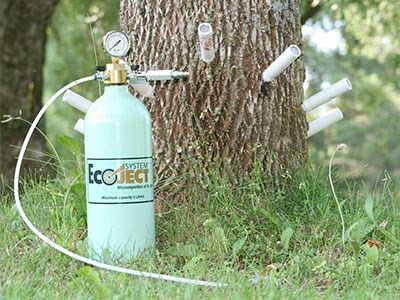A Sault Ste. Marie pest management firm received federal funding to search for the next generation of organic tree pesticides.
BioForest Technologies and company president Joe Meating want to dive deep into tree chemistry with an eye on producing new pest control tools.
The growing 25-employee company has received much media attention for bringing TreeAzin to market, a bio-product that safeguards trees from invasive and damaging insect species like the emerald ash borer.
Now the company is out to cover new ground after receiving $160,000 from the National Research Council of Canada’s Industrial Research Assistance Program in July.
“We think there may be an opportunity here to go to the next level in terms of pesticides,” said Meating.
He explained there’s an evolutionary and symbiotic relationship that seems to exist between communities of fungi found on almost every tree worldwide.
There’s endophytic fungi that grows on the inside fibres and epiphytic fungi on the outside. Both groups appear to serve various functions in the host tree’s defence and nutrition.
“There seems to be a real collaborative effort going on between the trees and fungi, and in some cases other organisms as well,” said Meating. “The best description of a tree is that it’s a community of organisms from insects to mammals to birds to microbials. We’re really just beginning to appreciate that.”
Their research will serve to better understand that relationship with the end goal of creating a commercial product.
Meating is reluctant to identify what specific tree species they’re targeting, but the field work will take them internationally.
“The net will be cast fairly broadly to get sense of what’s out there.
“Once we’ve identified a few of these organisms then we’ll zero in on various aspects of their growth and behaviour to see if we might be able to enhance that.”
Meating cautions they’re a long way from commercialization.
“Right now we’re at a very basic level. We’ve guesstimated between now and producing anything commercially is probably five to seven years. And we’re in year one.”
The research includes collaboration with Algoma University’s microbiology group.
“I find it interesting that we’re looking at trees quite differently than we were five years ago,” said Meating. “It’s slow and agonizing stuff because it seems to be very complicated, but as more people work on it, some of the complexity is being peeled away.”
R & D has been a big part of the company since 1996, when Meating co-founded the company after leaving his as a forest insect control officer with the Canadian Forest Service (CFS) in the Sault after 16 years. He worked with CFS to develop and market TreeAzin.
Azadirachtin, an active ingredient used in TreeAzin, is derived from neem tree seeds in India. When injected into a tree before bugs like the emerald ash borer arrives, it’s proved particularly effective at killing hatched larvae in the tree tissue.
Unlike harsh chemical applications, which can linger in the environment for years, azadirachtin breaks down when exposed to sunlight and water in soils.
To deliver the formulation to the tree, BioForest developed its own injection system.
TreeAzin has been readily adopted by municipalities in Ontario and Quebec where the emerald ash borer has savaged tree populations.
Through its ongoing research, the company wants to add more products to its catalogue.
“I’d say it’s accelerating now that we’re a bit more successful,” said Meating. “The treasury is richer.
With branch offices in Prince Albert, Toronto, and Fordland, Missouri, Meating said their primary goal is to make better inroads in the U.S. market where they face stiff competition from manufacturers making a cheaper product.
The company recently moved from an upper-story office in the downtown to a 6,000-square-foot office and warehouse space in a north-end industrial park which serves as the sales and tech support hub.
TreeAzin’s formulation is done at a licensed chemical facility in Burlington. The machining of the Eco-Ject parts is done at different locations and assembled in the Sault.




